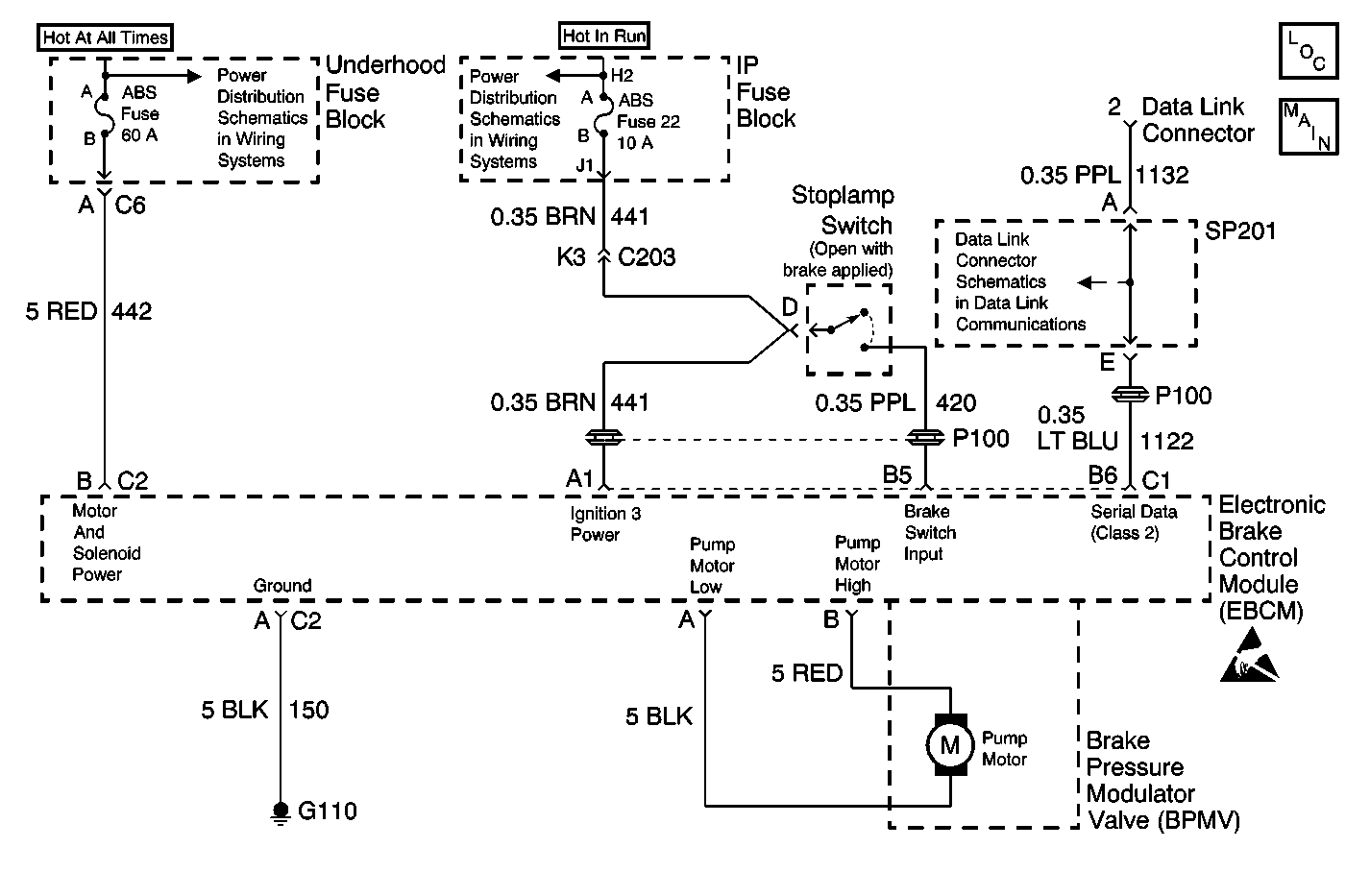
Circuit Description (DTC C0265/C0266)
C0265
Whenever the ignition is turned to RUN, the EBCM microprocessor commands the internal EBCM relay closed (after bulb check). Vehicle battery voltage is applied through the closed EBCM relay contacts to the high side of all six solenoid coils (3 isolation solenoid coils / 3 dump solenoid coils). All six solenoid coils have a feedback path to the EBCM microprocessor from the low side of each solenoid coil. The EBCM microprocessor monitors the control lines to the EBCM relay and the six solenoid coils. When the EBCM microprocessor commands the EBCM relay closed, it expects to see the feedback voltage on all six solenoid coils change from low to high. If after 100 miliseconds it does not see that change, the EBCM microprocessor assumes that the EBCM relay contacts are stuck open, or that the relay coil is open and the DTC is set.
C0266
Whenever the ignition is turned to RUN, the EBCM microprocessor commands the internal EBCM relay closed (after bulb check). Vehicle battery voltage is applied through the closed EBCM relay contacts to the high side of all six solenoid coils (3 isolation solenoid coils / 3 dump solenoid coils). All six solenoid coils have a feedback path to the EBCM microprocessor from the low side of each solenoid coil. The EBCM microprocessor monitors the control lines to the EBCM relay and the six solenoid coils. Before the EBCM relay is commanded closed (after bulb check) the EBCM microprocessor expects that the feedback lines if all six solenoid coils will be low. If the feedback lines report a high condition, the EBCM microprocessor assumes that the solenoid coils are stuck colsed, and the DTC is set
Conditions for Running the DTC
C0265
| • | Ignition switch in the RUN position. |
| • | The ABS bulb check is completed |
| • | EBCM internal relay command given |
C0266
| • | Ignition switch in the RUN position. |
| • | The ABS bulb check is completed |
| • | EBCM internal relay command not given |
Conditions for Setting the DTC
C0265
Low feedback voltage exists on all six solenoid driver circuits when high voltage is expected (solenoids are not energized)
C0266
High feedback voltage exists on all six solenoid driver circuits when high voltage is expected (solenoids are not energized)
Action Taken When the DTC Sets
| • | The ABS indicator lamp turns on |
| • | The ABS disables |
Malfunction responses to DTC C0265/C0266 vary, depending on the affected subsystem.
| • | ABS--Ignition latched |
| • | DRP--DRP critical (except for DTC C0266 which is non critical) |
For a detailed explanation of DTC malfunction responses, refer to Self-Diagnostics
Conditions for Clearing the DTC
| • | Repair the conditions responsible for setting the DTC. |
| • | Use the Clear DTCs function on the Scan Tool |
Diagnostic Aids (DTC C0265)
DTC C0265 usually sets because of an open relay coil or non-closable relay contacts. The relay is located within the EBCM. The relay is not serviceable. If the test does not repair the DTC, then replace the EBCM.
If DTC C0265 appears with other DTCs repair the other DTCs first. Clear all DTCs. Then run three function tests with the Scan Tool. Refer to this diagnostic table if DTC C0265 resets.
Diagnostic Aids (DTC C0266)
DTC C0266 usually sets when the relay contacts are stuck closed. The relay is located within the EBCM. The relay is not serviceable. If the test does not repair the DTC, then replace the EBCM.
Test Description
The numbers below refer to the steps in the diagnostic table:
-
This step determines the battery voltage available to the EBCM.
-
This step verifies that the motor and solenoid power circuit is OK.
-
This step determines if the ignition 3 power and signal ground circuits are OK, then attempts to determine if the DTC will set again during a road test.
Step | Action | Value(s) | Yes | No | ||||||||
|---|---|---|---|---|---|---|---|---|---|---|---|---|
1 | Did you perform the ABS Diagnostic System Check? | -- | Go to Step 2 | Go to Diagnostic System Check | ||||||||
Is the connector in good condition? | -- | Go to Step 3 | Go to Step 6 | |||||||||
Connect the a test lamp between the motor and solenoid power circuit and a good ground. Does the test lamp illuminate? | -- | Go to Step 4 | Go to Step 5 | |||||||||
Does the DTC set? | -- | Go to Step 7 | Go to Diagnostic Aids | |||||||||
5 | Test the motor and solenoid power circuit for an open/high resistance or short to ground. Refer to Circuit Testing and Wiring Repairs in Wiring Systems. Did you find and correct the condition? | -- | Go to Step 8 | -- | ||||||||
6 | Repair the 2-way EBCM harness connector. Refer to Connector Repairs in Wiring Systems. Did you complete the repair? | -- | Go to Step 8 | -- | ||||||||
7 | Replace the EBCM. Refer to Electronic Brake Control Module Replacement . Did you complete the replacement? | -- | Go to Step 8 | -- | ||||||||
8 | Operate the vehicle under the Conditions for Running the DTC as specified in the supporting text. Does the DTC set? | -- | Go to Step 2 | System OK |
